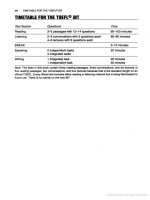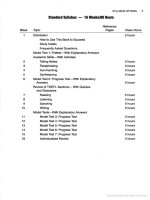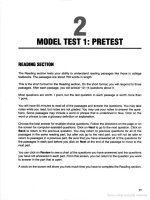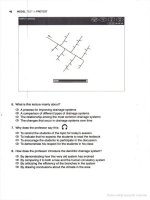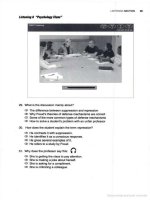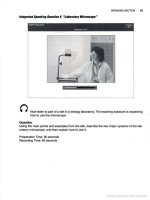Toefl ibt internet based test 2006 - 2007 part 49 ppsx
Bạn đang xem bản rút gọn của tài liệu. Xem và tải ngay bản đầy đủ của tài liệu tại đây (887.71 KB, 7 trang )
MODEL
TEST .nlEADING SECTION
33
1
PART
III
Rud/.,
4 u
TIUI
DI
,1ta1
DlrI,."
The Challenge
of
Technology
and
Equi
ty
In
fo
rm
a
tion
t
echno
l
og
y is influenci
ng
the way many
01
us live and work
today.
We
use the Inlernet to look and apply lor jobs, shop, conduct research,
make airline reservations, and explore areas
01
Interest.
We
use e-mail and the
I
ntemelto
communicate instantaneously with friends and business associates
around the world. Computers are commonplace in homes and the workplace.
-+
_"'-11\0
ffiliiiI;J/"OI
l
n__._JO
__
_
~
-=-~'.
!O
IlrittmItJ
Only 6 percent
of
the population in developing countries are con-
nected to telephones. Although more than
94
percent of U.S. households have
a
telephone, only
42
percent have personal computers at home
and
26
percenl
have Inlemet access.
The lack of what most of us would consider a basic com-
munications
necessity-the
telephone-does
not occur
Just
In
developing
nallons.
On some Native American reservations only
60
percent of the
JiiINlIi
have a telephone. The move
to
wireless coonections may j!!iii!iiItI
the need for telephone lines>
001
if
does nol remove lhe barrier to
equ
ipmenl
costs.
~
Who has Internet access? Fifty percent of the children in urban households
with an income over
$75
,000
have Internet access, compared with 2 percent of
lhe children
In
low-income, rural households. Nearly half of college-educaled
people have Intemel access, compared
10
6 percenl of those with only some
high school educalion. Forty percent
of
households with two parents have
access;
15 percent of lema
Ie,
single-parent households do. Thirty percent of
while households, 11 percent of black households, and 13 percent of Hispanic
households have access. Teens and children are the
two
fastest-growing seg-
ments of Intemet users. The digital divide between the populallons who have
access to the
In
ternet and Information technology tools
Is
based on income,
race, education, household
type, and geographic location. Only 16 percent of
t
he
rural
poor,
rural and central
city
minoriti
es
, young householders, and single-
parent lemale hOuseholds are connected.
~
Another problem that exacerbates these disparities
is
that African-Americans,
Hispanics, and
Native Americans hold few of the jobs in in/ormation technology.
Women hold about
20
percent
01
these jobs and are receiving fewer than
30
percent of the computer science degrees. The result is that women
and
mem-
bers
01
the most oppressed ethnic groups are nol eligible lor the
Jobs
with the
highest salaries at graduation. Baccalaureate candidates with
degrees in com-
puter science were offered the highest salaries 0/ all new college graduates In
1998 at S44,949.
M
Ichr,
:1y
klfr
prtN"v
332
MORE
MODEL
TESTS
Do
similar disparities exist
in
schools?
Ilil
More than 90 percent
of
all
schools
In
the country are wired with
at
least
one
Internet connectioo.
[Ell
The
number of classrooms with Internet connections diffe
rs
by
the income level of
students. Using
the percentage of students
who
are
eligible
for
free lunches
at
a school to determine income level,
we
see that nearty twice as many of the
schools with
lTIOfe
affluent students have wired classrooms
as
1M
with high
of
low-Income
students,
ICl
-+
Access
to
computers and
the
Internet will be Important In reducing dispari.
ties
belWeen
groups,
[DI
lt
will require greater equality across diverse groups
whose members
develop knowledge
and
skills
In
computer
and
Information
technologies.
If
computers
and
the internet
are
to
be
used to promote equality,
they will
have
to become accessible to populations thai cannol currently afford
the equipment
which needs to
be
updated every three years or
so.
However,
access
alone
is
nol enough. Students will have
to
be
interacting with the tech-
nology in authentic settings.
As
technology becomes a tool for learning
in
almost all courses taken
by
students,
It
will be
seen
as
a means to
an
end
rather than
an
end
In Itsell.
If
it
Is
used
In
culturally relevant ways, all studoots
can benefilfrom its power.
40.
Why
does the author mention the telephone
In
paragraph
2?
<D
To
demonstrate that even technology like the telephone
Is
not
available to all
<D
To
argue that basic telephone service
Is
a first step to using the tntemet
<D
To
contrast
the
absence
of
telephone usage with that
of
Internet usage
<D>
To describe the development of communications from telephone to Internet
Paragraph
21s
marked with an arrow 1
-+1
.
41
. Which of
the
sentences below besl expresses the
In
formation
In
the highlighted statement
in
the passage? The other choices change
the
meaning or leave out important information.
<D Most of the people
in
the world use the Internet
now
because the number 01 comput·
ers has
been
increasing every year.
<D The number of people who u
se
co
mpute
rs
and the Internet
Is
Increasing every
year,
but
most
people
in
the world still
do
not
have connections.
<D
The number of computers that
can
make
the
Internet available
to
most of
the
people
in
the wofld
is
not
increasing
fa
st
enough.
<D>
The
Internet
Is
available
to
most
oflhe
people
In
the world,
even
though they don't
have their
own
computer terminals.
42.
The
word residents
in
the passage
is
closest
In
meaning to
<D
homes
<D
towns
<D
people
<D>
locations
Malc'ltll chrancnv
a'
~rTl
prav~
MODEL
TEST 4IREADING
SEC
TION
333
43
.
The
word
eliminate
in
the
passage is closest
in
mean
i
ng
to
CD
accept
(J)
dispute
<P
define
<1>
remove
44
.
Based
on
in
formati
on
in paragraph
3,
which
of
the
following
best
explains
the
term
"digital
divide?"
<D
The
number
of Internet
users
in
developing nations
(J)
The
disparity
In
the
opportunity
to
use
the
Internet
<P
Differences
in
socioeconomic levels
among
Internet users
(JtI
Seg
ments
oltha
population
with
Internel access
Paragraph 3
is
mar1<ed
with
an
arrow
[
-+
).
45.
Why
does
the
author give
deta
i
ls
about
the
percentages
of
tnternet users
in
paragraph 3?
<D
To
prove
that there are differences
in
opportunities
among
social groups
CD
To
argue
lor
more
Internet connections
at
all levels
01
society
<P
To
suggeslthatlmprovements
in
Internet access are beginn
ing
10
take
place
<1>
To
expla
in
why
many
people
have
Internet connections
now
Paragraph 3
is
mar1<ed
with
an
arrow
[ +].
46
. According
to
paragraph 3,
wh
i
ch
of
the
following households
would
be
least
likely
to
have
access
to th
e Internet?
CD
A
household
with
one
parent
CD
A black household
CD
A H
is
panic
househOld
<1>
A household
with
both
parents
Para
graph
31
s
mar1<ed
with
an
a
rrow
[
+
].
47
.
The
word
1bWi§
In
the
passage
rele
rs
to
<D cl
assrooms
CD
students
CD
schools
<1>
concent
rat
ions
Mille
1<11
chr
~y
''Sky
prfr.tv
334
MORE
t.400EL
TE
STS
48
. According to paragraph
4,
why
are fewer women and minorities employed
In
the field
of
computer technology?
o® They are not admitted to
the
degree programs.
CD
They do not
possess
the educational qualifications.
CD
They do not have an interest in technology.
a> They prefer training for
jobs
with higher salaries.
Paragraph
4 is marked with an arrow [ ].
49
. The word cooceOlratjoos in the passage is closest
in
meaning to
o®
protections
CD
numbers
<l:) conlldence
a>
suppan
so
. What can be inferred from paragraph 6 aboot Internet access?
o® Betler computers need to be designed.
CD
Schools should provide
newer
computers
fOf
students.
<l:) The cost
of
replacing equipment is a problem.
a> Technology will be more helprul in three years.
Paragraph
6
is
marked with
an
arrow [ 1.
51. Look at the f
our
squares
(-
I that show where the following sentence
co
uld
be
Inserted
In
the passage.
Thu.
, the
.tudent.
who are mo. t unlikely to have
accn
. at home
al
. o do not have
aceesa
In
their
school.
, Inerea.lng the divide between
group.
even further.
Where could the sentence best be added?
Cilek
on a square
(_
jto
insert the sentence in the passage.
M 1
flal
chranCllY
a'
sk~ml
pravv
MODEL TEST
41l'1EADING
SECTION 335
52.
Directions:
An
introduction
fo
r a short summary of the passage appears below. Complete
the summ
ary
by selecting the THA
EE
answer choices th
at
mention the most important
points
In
the passage. Some sentences do not belong In the summary because Ihey
express ideas that are not included in the passage
01"
are
minor points from
the
passage.
This
qUB8t1on
Is worth 2
po
ints.
The availability
of
technology
is
unequal
throughout
the world.
•
•
•
Answer Choices
tal
Currently, only about 10 percent of
al
l
the
schools in the United States are n
ot
wired
fOl"
Inlemet access.
IDl
Internet access
is
limited by education,
income, geographic location, race, and
the
age and marital status
01
the head
01
household.
(B]
Less aHluent schools have fewer Internet
connections, and minorities as well as
women hold lewer computer science
degrees.
ICl
Children and teenagers
are
the two
fastest growing segments
01 the popula-
tion
gaining access
to
the Internet.
Rudlllg 5 "
Thfl
Ero/utl""Il' BlnII"
Birds Began as Feathered Aaptllas
lEI
Comput
er
science graduates can earn
almost
$50,000.
!EI
Access to the Internet
is
one way to
encourage equality among diverse
groups
Birds
evolved during
the
great reptilian radlallon of the Mesozo
ic
era. Amni-
otic eggs and scales on the legs
are
just two of
the
reptili
an
featu
res
we
see in
birds. But modem birds
look quite different from modem reptiles because
01
their leathers and other distinctive
fl
ight equipment.
Characteristics
01
Birds
-+
Almost every part
01
a typical bird
's
anatomy
Is
iDiiIfIiiIln
some
way
Ih
at
enhances lIight. The bones have an Internal structure that
is
honeycombed.
making
them strong but light.
Th
e skeleton
of
a frigate bird, lor instance, has a
wingspan of
more than 2 meters but weighs only about
113
grams. Another
adaptation reducing the weight
of
birds is the absence of some organs.
Females,
fo
r Instance, have only one
ovary.
Also, modern bi
rds
are toothte
ss,
an adaptation that trims the weight of the head. Food
is
not chewed in the
mouth but ground in the gizzard, a
digestive organ near the stomach. (Croco-
dlles
also have
giuards,
as did some dinosaurs.) The bird's beak, made of
ker-
M
",
"",,,
336
MORE
MODEL
TESTS
alin, has proven
10
be very adaplable during avian evolulJon, laking on a great
variety
01
shapes suitable
lor
different diets.
Flying requires a great expenditure
01
energy from an active metabolism.
Birds are endothermic; they use their own metabolic heat to maintain a warm,
constant
body
temperature. Feathers and, in some species, layers of fal pi'll'"
vide insulatiOn that enables birds to retein W metabolically generated heat.
An efficient respiratory system and a circulatory system
with a lour-chambered
heart keep tissues
well supplied with oxygen and nutrients, supporting a high
rate of metabolism. Tha lungs have tiny tubes leading to and from elastic air
sacs
that help dissipate heat and reduce the density
01
the body.
For safe
fl
ighl, senses, especially vision, must
be
acute. Birds have e)(ool-
lenl eyes, perhaps the best of all the vertebrates. The visual areas of the brains
are
well developed, as
are
the motor areas; Itlght also requires e)(cellent
coor
-
dination.
With brains
proportionately larger than lhose of reptiles and amphibians,
birds
generally display very comple)( behavior. Avian behavior
Is
partlC\Jlarly
intricate during breeding season, when birds engage in
lIilXliili riluals
01
courtship. Because eggs ate shelled when laid, fertilization must
be
internal.
Copulation
Involves contact between the males' vents, the openings to their
cloacas. Alter eggs are laid,
Ihe avian embryo must be kept warm through
brooding by
the mother, falher,
or
both, depending on the species.
-+
A bird's most obvious adaplation
lor
flight Is its wings. Bird wings are airfoils
thai illustrate
Ihe same principles of aerodynamics as the wings of an airplane.
Providing power for flight. birds flap their wings by contractions of large pectoral
(breast) muscles anchored to a keel on the sternum (breastbone). Some birds,
such as eagles and hawks, have wings adapted for soaring on air currents and
flap their wings only occasionally; other birds, Including hummingbirds, must
ffap conlinuously
10 stay aloft.
In
either case, Il ls the shape and arrangement
01
tho loathors thol form Iho wings in
to
nn airfoil. Tho Inslost birds oro Iho nppro-
priately named swilts, which can fly 170 kmlhr .
In
being both e)(tremely light and strong, fealhers are among Ihe
mOst
remarkable
01
vertebrate adaptations. Feathers are made
01
keratin, the same
protein that forms our
hair
and fingernailS and the scales of reptiles. Feathers
may have functioned first
as
insulalion during the avolutiOn of endothermy, only
later being co-opted
as flighl equipment.
The evoluti
on
of flight
requ
i
red~
alteration in body lorm, but flight pro-
vides many benelits.
!AI
It enhances hunting and scavenging: many birds
e)(ploit flying insects,
an
abundant, highly nutritious food resouroo.
1m
Flight
also provides ready escape from
earthbound predators and enables
so
me
M 1
rial
chranCllY
a'
sk~ml
pravv
MODEL
TEST
4IREA01NG
SECTION
337
birds to migrate great distances to utilize different
food
resources and seasonal
breeding areas.
ICJ
The bird that travels farthest in its annual migration
is
the
arctic tem, which
flies round-trip between the
North
Pole
and
South Pole each
year.
!OJ
-+ Analyses of fossilized skeletons support the hypothesis that the closest
reptilian relatives
of
birds
were the
theropods
, a group
01
relatively small,
I carnivorous dinosaurs. Most researchers that the ancestor
;;,;;~,;;;;;,.
,
.;;;;
.
;;
birds undoubtedly bring us closer to
understanding how
these masters
01
the sky evolved from nonflying reptiles.
Glossary
brooding: to hatch eggs by sitting on the nest
cloacas: the opening to the reproductive and intestinaltracl
53. According to paragraph 2, how did bir
ds
adapllO achieve efficient flight?
<D They developed a skeleton with lewer bones.
eD Their organs became smaJleroverlime.
<D Most
01
their weight
was
distributed in their heads.
(l)
Teeth were replaced
by
a beak made
01
keratin.
Paragraph
21s marked with an arrow [-+).
54
. The word modWed in the passage is closest
In
meaning to
<D
made different
eD made better
<D
made smaller
CD>
made modem
55 The w()(d
1ba.it.ln
the passage refers
10
(D
feathers
CD
species
<D
layers
CD>
birds
56. The w()(d elaborate in the passage is opposite
in
meaning to
<D simple
(I)
quiet
'"
""
""
""'"
Mil' rial chr
n~
iI
'"Sky
pravv

